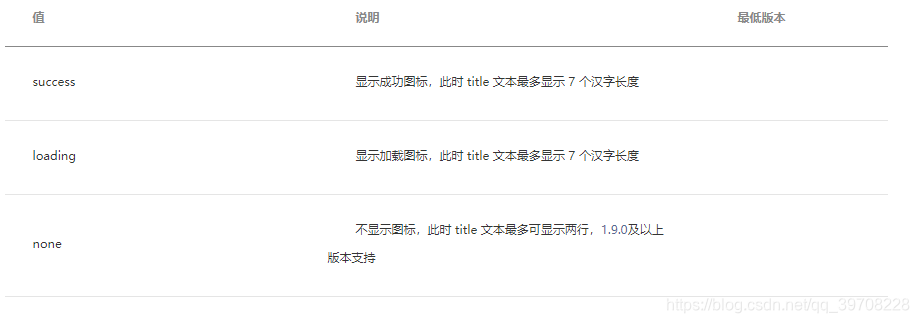小程序(十三)小程序弹窗wx.showToast及wx.showModal
本文共 761 字,大约阅读时间需要 2 分钟。
我这版的小程序中,没有使用到确定取消那样的弹窗,基本上用到的就是,加载中,成功或者失败那种消息提示类的弹窗。
微信本身给我们提供了一个这样的弹窗wx.showToast(Object object),挺好用的,我也没有再去折腾第三方组件的消息提醒弹窗。
Object object

 这些事官方给出的参数。
这些事官方给出的参数。 注意,icon设置为none的时候,就是没有图标纯文字的状态,这个就很好了。
这个玩意既能有图标,又能没有图标,百变小能手啊。
注意一下,自定义显示图标不能是动图,他这是只加载图片的第一帧,所以,动图是没有那种效果的,当然,这个弹窗比较简单,对样式要求不高的同学可以尝试一下:
示例代码:
wx.showToast({ title:'加载中……', icon: 'loading',//图标,支持"success"、"loading" // image: '/images/load.gif', duration: 1500,//提示的延迟时间,单位毫秒,默认:1500 mask: true,//是否显示透明蒙层,防止触摸穿透,默认:false }); wx.showModal:
delete(){ wx.showModal({ title: '', content: '是否确认删除', success(res) { if (res.confirm) { console.log('用户点击确定') } else if (res.cancel) { console.log('用户点击取消') } } })} 效果如下:
 有好的建议去,请在下方输入你的评论。 欢迎访问我的小程序:
有好的建议去,请在下方输入你的评论。 欢迎访问我的小程序: 
转载地址:http://vahwz.baihongyu.com/
你可能感兴趣的文章
Netty:原理架构解析
查看>>
Network Dissection:Quantifying Interpretability of Deep Visual Representations(深层视觉表征的量化解释)
查看>>
Network Sniffer and Connection Analyzer
查看>>
Network 灰鸽宝典【目录】
查看>>
Network-Emulator Network-Emulator-Toolkit网络模拟器使用
查看>>
Networkx写入Shape文件
查看>>
NetworkX系列教程(11)-graph和其他数据格式转换
查看>>
Networkx读取军械调查-ITN综合传输网络?/读取GML文件
查看>>
NetworkX:是否为每个节点添加超链接?
查看>>
network小学习
查看>>
Netwox网络工具使用详解
查看>>
Net与Flex入门
查看>>
Net任意String格式转换为DateTime类型
查看>>
net包之IPConn
查看>>
net发布的dll方法和类显示注释信息(字段说明信息)[图解]
查看>>
Net和T-sql中的日期函数操作
查看>>
Net处理html页面元素工具类(HtmlAgilityPack.dll)的使用
查看>>
Net操作Excel(终极方法NPOI)
查看>>
Net操作配置文件(Web.config|App.config)通用类
查看>>
net网络查看其参数state_dict,data,named_parameters
查看>>